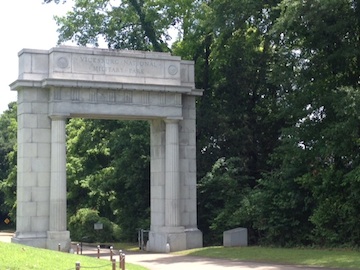Day Three: The Siege of Vicksburg
The siege of Vicksburg nearly kills us.
The heat index soars into the low 200s. Centigrade. The thermometer actually says something like 89, but it’s hard to read with all the sweat stinging my eyes. The humidity is high enough to choke a cat—or a Yankee. I might live in Virginia now, but my body has acclimated to Northern climes for 45 years, so my physiology doesn’t care about the address on my driver’s license. This Mississippi afternoon is killing me.
I keep myself hydrated, but that only barely keeps me going. A sandwich now and then doesn’t help much, either. There’s something about the heat that saps me.
“This isn’t like Virginia heat,” says Dan, who’s feeling it, too. “I’m used to that heat back home. This is something different entirely.”
By this point in 1863, the Federal army had settle into siege around Vicksburg. Heat, dirt, flies, and humidity—ugh. But at least they had food and water. The Confederates trapped in the city had ever-decreasing supplies. Their commander, John Pemberton, cut rations in half, then cut them in half again. Dogs and cats began to disappear. Then horses.
Starvation was their slow, inexorable companion.
That had to be awful enough, but to suffer like that in the sweltering heat must’ve been misery of a kind I haven’t been able to really appreciate until today.
Grant had 50,000 Federals ringing the city, with 31,000 Confederates bottled up inside. On May 19 and again on May 22, Grant assaulted the Southern works but was repulsed both times; that’s when he settled on siege.
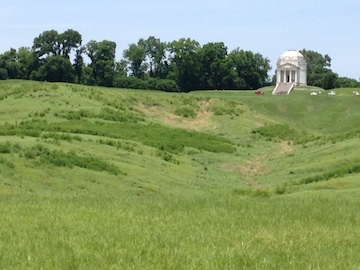 We start our assault at the visitor center, where the movie gives us a good overview of the park story. I’m a Vicksburg newbie, so I need the Cliffs Notes version of the story. Later, I hear a woman at the park bookstore asking for something similar. Good thing we finally have an ECW book in the works on this one, I think. We’ve been weak in the west but are now finally positioned to take care of that.
We start our assault at the visitor center, where the movie gives us a good overview of the park story. I’m a Vicksburg newbie, so I need the Cliffs Notes version of the story. Later, I hear a woman at the park bookstore asking for something similar. Good thing we finally have an ECW book in the works on this one, I think. We’ve been weak in the west but are now finally positioned to take care of that.
Outside, the park’s Tour Road snakes along the Federal and then Confederate lines in a northern and a smaller, southern loop—sixteen miles of road in all. Thirteen hundred monuments dot the landscape, putting it in the same league as Gettysburg or Chickamauga as far as monumentation. Unlike those two battlefields, though, where there’s tremendous variety and character to the monuments, there’s a standardization about the monuments here from each state. Indiana’s look like thick, low rectangles, with inscriptions on their tabletop surfaces. Ohio’s looks like small, partially unrolled scrolls. Iowa’s look like mini Greek temples.
One thing that really surprises me and which I like: a tremendous number of regimental colonels have monuments dedicated to them, ornamented with bas-relief portraits. Similarly, most general officers have larger-than-life busts on pedestals along the Tour Road. A few have statues. There are statues of a few governors on hand, too.
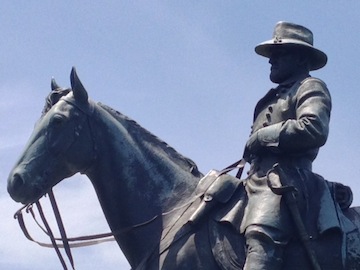 Grant dominates the landscape. He sits astride his horse, Cincinnati, looking out across the battlescape. There are two carved granite benches that flank him, inviting visitors to sit a spell, but Grant’s pose does not suggest that he wants to chat. There’s no path up to the benches, either, further discouraging visitation. Today’s raw, open sun and suffocating humidity discourage us, too.
Grant dominates the landscape. He sits astride his horse, Cincinnati, looking out across the battlescape. There are two carved granite benches that flank him, inviting visitors to sit a spell, but Grant’s pose does not suggest that he wants to chat. There’s no path up to the benches, either, further discouraging visitation. Today’s raw, open sun and suffocating humidity discourage us, too.
The only other Union officer who has an equestrian statues is Grant’s perpetual pain in the ass, John McClernand, who sits near the Iowa monument—which also includes a magnificent equestrian statue—on the southern end of the line. Leave it to McClernand to try to outshine his commander, even here, even now. Grant gave McClernand the boot after the corps commander issued an order to his men patting them—and himself—on the back for action on May 22 while badmouthing the other corps.
 Sherman is nowhere to be found. Neither is McPherson. McPherson gets forgotten so often that I’m not surprised, but Sherman’s absence strikes me as an act of postwar passion-aggression. I know he doesn’t get a lot of love in the South.
Sherman is nowhere to be found. Neither is McPherson. McPherson gets forgotten so often that I’m not surprised, but Sherman’s absence strikes me as an act of postwar passion-aggression. I know he doesn’t get a lot of love in the South.
The thing that impresses me the most is the battlefield’s landscape. The terrain rolls and splashes like the massive waves of an angry ocean. The earthworks are well preserved, but the really stunning thing is that the land between the lines still bears the scars of bombardment. Time and time again, we pull over, get out, and can’t believe the view.
There’s plenty else to look at: the temple-like Illinois monument with its domed roof, that pays homage to Grant and Lincoln; the U.S.S. Cairo Museum, which showcases the salvaged ruins of a city-class ironclad; the national cemetery, the final resting place of 17,000 soldiers.
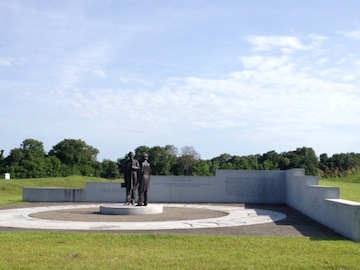 The most peculiar monument on the field is the Kentucky Memorial, installed between the lines on the south end of the field in October of 2001. The memorial features Lincoln and Davis—both born in Kentucky—in the middle of a circle that says “United we stand. Divided we fall.” Inscriptions point out Kentucky’s contributions to both sides of the war, including both presidents. It’s a little surreal, to be honest, with a huge emphasis on commonalities and reconciliation.
The most peculiar monument on the field is the Kentucky Memorial, installed between the lines on the south end of the field in October of 2001. The memorial features Lincoln and Davis—both born in Kentucky—in the middle of a circle that says “United we stand. Divided we fall.” Inscriptions point out Kentucky’s contributions to both sides of the war, including both presidents. It’s a little surreal, to be honest, with a huge emphasis on commonalities and reconciliation.
Nearby, there’s a bust of John Breckinridge, also a Kentuckian. I send a photo to my wife, who is a great-great-great-great granddaughter.
I run into Jeff Davis elsewhere on the field. There, he’s carrying a semi-furled Confederate flag over his left shoulder. He looks positively invigorated by the heat and humidity—quite a contrast to the quiet resignation with which he bore the rain in Montgomery the day before.
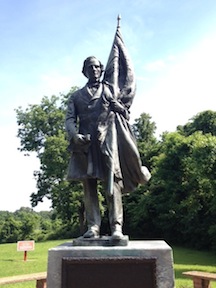 Davis, as a native of the Magnolia state, gets a lot of love in Mississippi. The Old Courthouse Museum downtown, which we also visit while in town, has a whole room devoted to him. (The museum has one of the coolest collections of “stuff” I’ve ever seen—definitely worth the $5 admission charge.)
Davis, as a native of the Magnolia state, gets a lot of love in Mississippi. The Old Courthouse Museum downtown, which we also visit while in town, has a whole room devoted to him. (The museum has one of the coolest collections of “stuff” I’ve ever seen—definitely worth the $5 admission charge.)
We have to go out of the park to see a lot, actually. The park used to encompass the entire siege line, but in the 1950s, the Park Service turned over the lower third of its property to the city in exchange for some road closures elsewhere in the park. There are still monuments aplenty along what is now South Confederate Drive, but stopping to admire them as we did on the Tour Road is a lot more dangerous. My Virginia license plates probably don’t engender any sympathy as a fellow Southerner; the glares I get peg me as just some out-of-town rubbernecker.
We finally make it to the river’s edge undented, where a stocky artillery piece dominates the heights. This is the Louisiana Battery, a position so formidable it was never assaulted. I can see Louisiana on the far side of the river and wonder how these soldiers felt to be so close to home yet so far away.
A little farther to the south are two other detached units of the park: South Fort and Navy Circle.
To cap off our tour, we conducted a sortie over the river to the town of Delta to visit Grant’s canal. In one of his attempts to bypass the city, he tried to dig a canal. The river, at the time took a long bend northward then south; by digging across the narrow base of this “U,” he hoped to avoid Vicksburg altogether. The canal caved in and flooded, though, foiling the plan.
Nearby, there’s a monument to the 9th Connecticut, a largely Irish unit that put their backs to work on the canal project.
We grab some dinner and, somewhere between the breadsticks and the mushroom pizza, we realize we’re not going to make our late-day drive to Tupelo. The heat has sapped us. Vicksburg has worn us down to the point that we can’t leave.
Which turns out to be just fine. We end up breaking out a few cigars and sit atop Navy Circle and watch the sun set over the Mississippi. The father of rivers still flows unvexed to the sea, and we’re happy to spend some time watching him. He brings a breeze with him. We all feel better.
The siege of Vicksburg has ended just fine.
